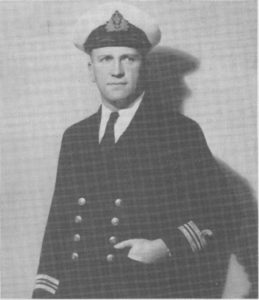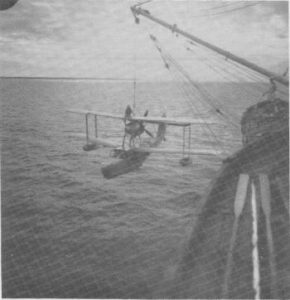- Author
- Davies, Barry
- Subjects
- Obituaries, Naval Aviation, Biographies and personal histories
- Tags
-
- RAN Ships
- HMAS Australia II, HMAS Westralia I, HMAS Manoora I, HMAS Perth I
- Publication
- September 1993 edition of the Naval Historical Review (all rights reserved)

Whilst documentation of our Naval history regarding ships and battles is well covered in our Naval Historical Review, these battles could not have been won or lost without the brave officers and men who so gallantly served our nation. Lt. Cdr. “Pally” Carr, as he was affectionately known, was unique in Naval history as the only serving Naval officer in the R.A.N. to receive the Distinguished Flying Cross. Air Commodore W.H. Garing, C.B.E., D.S.C., R.A.A.F. (Ret)., in his Valediction at the funeral of Lt. Cdr. Carr summed up the man when he described him as “A great and unbelievably courageous Australian”.
Born in 1908, Lt. Cdr. Carr was formally educated in Melbourne and in 1918, attended Geelong Grammar School where he spent four years. In 1922 he was selected as a Cadet to attend the R.A.N. College at Jervis Bay. He excelled as Chief Cadet Captain in 1924 and was King’s Medallist winner as the best all round Cadet. In the same year he won the Governor General’s Cup for the Best Individual All Round Sportsman. He graduated with distinction from the College in 1925. After graduating, “Pally” was sent to the U.K. where he spent four years at sea and on various courses, returning to Australia in 1930 as a Sub. Lt. Volunteers were called for at that time for secondment to the R.A.A.F., training as pilots. “Pally” volunteered, was accepted and spent two years flying seaplanes at Point Cook. Unfortunately, the Service rules at the time were rather Gilbertian and precluded an R.A.N. pilot from displacing R.A.A.F. pilots, who at the time were flying the R.A.N.’s sea-borne aircraft. During this period of secondment to the R.A.A.F., “Pally” wore R.A.A.F. uniform by day and Naval mess undress at night, except on ceremonial occasions when he reverted to Naval frock-coat. As a Lt. in the R.A.N., he was given the honorary rank in the R.A.A.F. of Flt. Lt. for which he dressed during the day. 1932 was an exciting year, as he qualified for his pilot’s Brevet wings and in 1933, he flew with Air Commodore W.H. Garing and they remained close friends for life.
“Pally” returned to sea-going service in 1935 as a fully qualified Naval pilot. As he was unable to fly with the R.A.N., the Naval Board then offered him an Observer’s course in the U.K., which he accepted, arriving in England in 1936. After qualifying, he spent four years serving in aircraft carriers H.M.S. FURIOUS, H.M.S. COURAGEOUS and H.M.S. ARK ROYAL in European and Mediterranean waters.

In July 1939, “Pally” joined H.M.A.S. PERTH, which sailed from Portsmouth, bound for Australia via New York. PERTH was to represent Australia at the opening of the World Fair. After leaving New York on the homebound voyage, war became imminent and H.M.A.S. PERTH was held in Jamaica, to be included in the Caribbean Naval Force, which included Canadian and French ships in that area. PERTH had no planes but H.M.S. ORION, carrying the Senior Officer, had two Seafox float-planes embarked with a spare aircraft held in Jamaica. “Pally” was transferred to H.M.S. ORION where he flew the Seafox float-planes for six months – the only Allied war planes in the whole of the West Indies at the time.
In 1940 “Pally” returned to Australia to serve briefly in H.M.A.S. MANOORA, H.M.A.S. WESTRALIA and, for a short period at Pearce R.A.A.F. Base. At the end of 1940 he was sent back to Britain on loan to the R.N. After serving in the east coast of Britain Naval Air Stations at Arbroath and Crail, he was appointed to H.M. Carrier HERMES, operating in the Indian Ocean between Mombassa, the Seychelles, Mauritius and Ceylon. “Pally” was recalled to Australia, leaving H.M.S. HERMES in Trincomalee in April 1942. It is interesting to note that the day after his leaving H.M.S. HERMES, the ship was sunk by aircraft from a Japanese aircraft carrier. On safely arriving in Australia, “Pally” joined H.M.A.S. AUSTRALIA, taking part in the Guadalcanal landing and the Battle of Savo Island.
At the end of 1942 he was again attached to the R.A.A.F., serving briefly with No. 100 Torpedo Bomber Squadron based in Milne Bay, T.P.N.G. “Pally” was then posted to R.A.A.F. Command at Allied H.Q. in Brisbane. He initiated, in conjunction with the U.S.N., the highly-secret offensive minelaying campaign, using night-flying R.A.A.F. Catalinas of 11 and 20 Squadrons, working out of Cairns and Darwin. These operations ranged between Indonesia and the South China Seas. Air Commodore Garing stated in later years that he had personal knowledge that the operations were highly successful – at one stage, bottling up a considerable number of enemy warships for a whole fortnight. Unfortunately, in September, 1943, the Catalina in which “Pally” was flying was shot down off Pomala, in the Celebes. His mission at this time was testing, under operational conditions, a new American torpedo. The torpedo had a problem in that when its engine was fired , a great flash occurred, lighting up the aircraft, which could be seen for miles. It was because of this problem with a torpedo that “Pally’s” Catalina was shot down. Although he was a lone survivor, he did rescue one other member of the Catalina’s crew who died within 36 hours of being brought ashore. Unluckily, he was captured by the Japanese, being left in solitary confinement for six weeks in Sourabaya before being flown to Japan. He was then held prisoner of war in the infamous Naval Interrogation Camp at Ofuna, inland from Yokosuku. The torture inflicted on him by the Japanese was of the cruelest kind, but never once did he tell them what work he was in. I quote Air Commodore Garing, when giving “Pally’s” valediction, “I doubt if many servicemen could have endured the pain to which this unbelievably brave man was subjected”. In this hell hole, “Pally” was to endure eight months of his two years as a prisoner of the Japanese. After Japan was defeated he was repatriated to Australia. He took advantage of retirement open to ex P.O.W.s, shortly after his return. His bravery and devotion to duty was recognised when he was awarded the Distinguished Flying Cross.
He settled with his loving wife, Jean and family at Palm Beach where he ran a boatshed on the Pittwater, later selling the business and taking up the appointment of Information Officer at the Sydney Bureau of Meteorology, where he stayed until retirement in 1971.
Of special note, Lt. Cdr. Carr was at sea in H.M.A.S. PERTH on her war station off the South American coast on September 3, 1939 and for every one of the six Christmases of WWII, he was on active service – two years at sea in the Atlantic, one in Ceylon, one in New Guinea and two in Japan.
Lt. Cdr. Carr died in August 1990, aged 82. The data for this history was kindly supplied to me by Mrs Jean Carr and family. They have decided to donate to the Society, personal items which Lt. Cdr. Carr had retained from his unique Naval career, these items to be displayed in the Garden Island Naval Museum. Amongst his items, Lt. Cdr. Carr had a Naval Aldis signalling lamp, which he had connected to a 12V battery, keeping it in working order and testing it from time to time. This Aldis lamp is already on display in our Museum.




